When we think about the types of Dendrobiums, we usually divided them into two groups or categories, the soft cane Dendrobiums and the hard cane Dendrobiums. Even though that is correct and those two groups exist technically, they are not the correct way to classify Dendrobiums.
Others might think that the two classifications are Nobile and Phalaenopsis since those are the most widely known orchids. Again, this isn’t even close. Cultivation, care, and culture will differ and have been classified into more ways than just two distinct groups.
What are the different types of Dendrobium orchids that exist?
The dendrobium genus is classified into 5 distinct groups: Dendrobium phalaenopsis, Dendrobium spatulata, Dendrobium latouria, Dendrobium formosae, and simply Dendrobium. Each has their own growing requirements, culture, care, and specific patterns of growth.
Note: This group of 5 isn’t the only way to classify them. There are sometimes classifications with 6 or more, depending on the source you use. I’ll explain more of different classifications at the end of the article. First, let’s dive into how they are found in nature and what this fantastic genus offers us.
Habitat and Cultivation of the Dendrobium Orchids
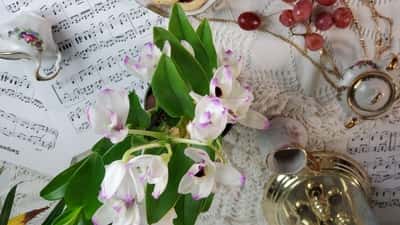
The Dendrobium genus is the 2nd largest orchid genus with over 1,400 cataloged species, only losing to Bulbophyllum, which comes in at 1st place.
The name Dendrobium offers little to suffice that gap since it comes from Greek and literally means “life on a tree”. Sadly, this describes all epiphytic orchids.
Since the Dendrobium genus is so vast, the growing conditions and culture vary from day to night, which is why it is important to know what type of Dendrobium you have so you can grow it well.
Dendrobium orchids are some of the most diverse orchids that exist, growing in vast areas that all differ in climate, altitude, humidity, and lighting. They grow from sea level up to 12,000 ft (3660m).
When you hear things like, “Dendrobiums are hard to grow,” or the famous, “ I can’t grow a Dendrobium. They just don’t like me,” don’t fall into this line of thinking.
Maybe the species they had was no the correct one for their climate and routine, or maybe they chose a species that was hard for beginners. In the Dendrobium genus, there are orchids from beginners to advance-growing orchids.
Before the Pangea, orchids grew natively in what is now Asia. With the spreading of the continents, you can now find Dendrobiums all around China, Japan, Malaysia, Philippines, India, New Zealand, and in Australia. The majority of the species come from Papa New Guinea, where over 500 species have been cataloged.
Don’t take Papa New Guinea’s hot and humid weather and lowland altitude as an all-inclusive guideline. Since Dendrobiums have scattered over such a large area is so huge, some have adapted to live in monsoon climates and others in extremely dry, cooler climates.
The one unifying element that ties this group together is the fact that they like to be rootbound in tiny pots and all like to receive bright light. All Dendrobiums have shorter roots (compared to the length of their canes) and need to have the pot fitting tightly around them. Everything else varies.
If you are new to Dendrobiums (and all other orchids as well), it’s best to start out with a hybrid and not a “pure” species. As the name suggests, a hybrid is a mix of two parent species.
Since species are very acclimated to their environment, if you make mistakes with watering, lighting, or fertilizing, they won’t be as forgiving as a hybrid will. A hybrid will have a mixture of the two parents, so they can cover more ground with mistakes. A hybrid will also more accustomed to living in wider conditions, with more options for cultivation.
Some are deciduous, which means the leaves fall off during winter as the orchid will take a short rest, called dormancy. The orchid will appear dead. (If you want more information on dormancy, this article about orchid dormancy is a good place to start.
The other classification (besides deciduous) is called persistent, which means they will take no winter rest (or a tiny winter rest), but the leaves still might fall. This is contrasted to evergreen, where the leaves never drop.
Types of Dendrobium Orchids
In the rest of this article, you’ll learn the five main divisions of the Dendrobium genus. Each one has specific care and growth patterns, as mentioned above. Research your specific type of Dendrobium to know what is best for each one.
1) Dendrobium Phalaenanthe
These Dendrobiums resemble the moth-shaped flower of the Phalaenopsis orchid, and that similarity is why they received this name. Den-phals, as they are also called, are warm growers, preferring higher light than the others. This category is classified as a good beginner orchid since they are fairly easy to maintain healthy during the year. They are also the most commonly found to purchase since they are the most hybridized on the market.
The pseudobulbs on these orchids are not fat nor rounded but similar to cylindrical canes that grow quite large, 2 to 4 feet (0.6 m to 12 m). It’s uncommon to hear them being referred to as pseudobulbs since they are called mostly “canes”. Their smaller rubbery leaves are around 3 to 6 inches (7.6 to 15cm) long.
On a new plant, the orchid will produce up to 5 inflorescences at a time. An older plant will reward you with around 20 inflorescences, beautifully hanging around the small pot.
Since these are warm-growers, found mainly in northeastern Australia and in areas near the equator, they don’t drop the winter temperature lower than 50° F (10° C) and don’t push the upper limit above 90° F (32.2° C).
The warm weather usually implies more watering, but whatever you do, let them dry out before watering again. When you water, use tons of water, more so than other orchids of its kind. Put it this way: they’re thirsty and drink tons but like to rest well before drinking again.
They don’t like the moist environment all the time, which makes them similar to the watering cycle of a Cattleya but unlike the Phalaenopsis.
They will also need a rest from water, breaking the cycle twice a year. You should not water them during these short periods. Still, they are considered persistent, and not deciduous.
In another very respected classification of Horticultural Groups of Dendrobiums elaborated by Rebecca Tyson Northern, these orchids would be classified as Type VI. (In her classification, there are 6 groups, and not 5 as I have in this article.)
Some Examples of Dendrobium Phalaenopsis Species:
- Dendrobium affine
- Dendrobium bigibbum
- Dendrobium lithicolum
- Dendrobium phalaenopsis
- Dendrobium superbiens
Note: Phalaenopsis and Bigibbum were once considered to be the same species. They are now separated, but you still might encounter a few “misnamed” orchids using the former classification.
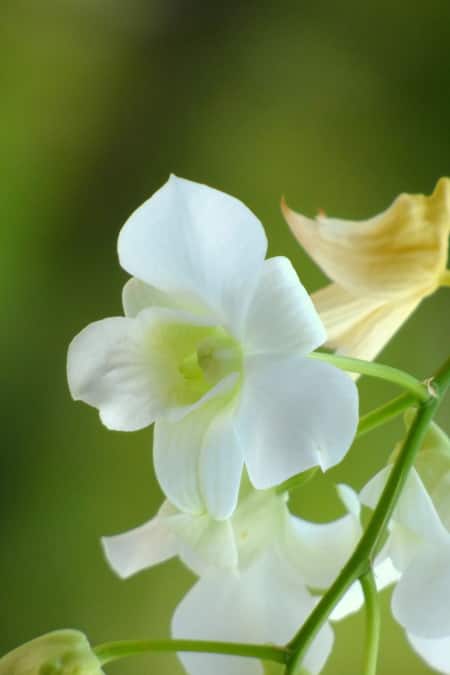
2) Dendrobium Spatulata
Spatulata orchids have long, horn-like projections that spiral into unique-shaped flowers, similar to an antelope horns or insect antennas. They are sometimes classified as Antelope Dendrobiums because of this. There are somewhere near 50 species of Dendrobium Spatulatas, all science-fiction or alien looking with intricate detail in each blossom.
Dendrobium Spatulata orchids are hot, tropical orchids and unlike the first category, they don’t require a rest period. These orchids bloom several times a year. That is why they are classified as persistent and not deciduous.
The culture and care of Dendrobium Spatulata are somewhat similar to the Phalaenanthe orchids, but without the rest period, longer light periods, and tons more of water.
They also like intermediate temperatures all year long, with no winter drop in degrees.
As for light, they are intermediate to high light orchids, but instead of placing them in a similar group to Cattleyas and Vandas, just prolong the time they are exposed to filtered light. They will do well outside and can get full sunlight as long as it is not during the hottest part of the day.
In another classification, this group is known as Type V, but can also overlap, containing hybrids of type VI, too.
These orchids are NOT recommended for beginners since they prefer higher humidity and higher light requirements that mimic tropical climates, which are hard to keep constant all year round.
Some Examples of Species:
- Dendrobium antennatum
- Dendrobium canaliculatum
- Dendrobium carronii
- Dendrobium cochliodes
- Dendrobium discolor
- Dendrobium gouldii
- Dendrobium Helix
- Dendrobium lasianthera
- Dendrobium lineale
- Dendrobium stratiotes
- Dendrobium strebloceras
- Dendrobium sutiknoi
- Dendrobium tangerinum
- Dendrobium williamsianum
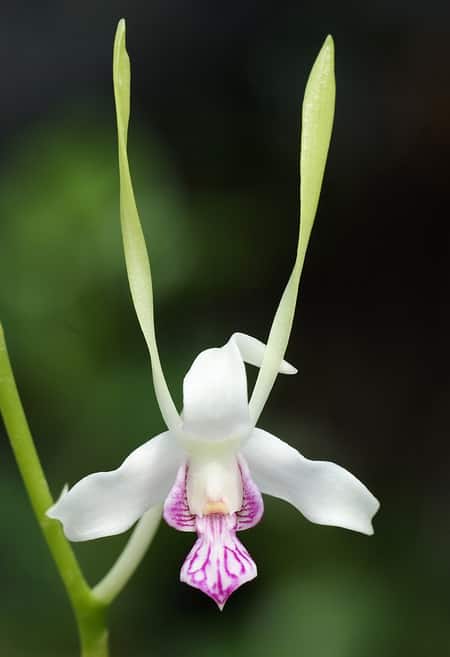
3) Dendrobium (Dendrobium)
Dendrobiums are probably the most common type of Dendrobium species due to the famous Dendrobium Nobile. Most people think of this purple flower with the white center when they visualize a Dendrobium.
There are two types of Dendrobiums, the pendulous or the erect. In the pendulous group, the flowers cascade from the base and flow over the pot, as the Nobile does. In the erect, they grow upward, and as time goes by, the weight of the flower increases from the flower spike in bloom, they slowly form a slight curve.
Nobile orchids are found in cooler-growing climates, or higher altitudes. They thrive in the cooler mountain bases of Southeast Asia, mostly southern China.Dendrobiums are also found in neighboring countries such as Burma, Thailand, Nepal, parts of India, and Vietnam.
Even though these countries get quite hot, they also have mountainous regions, where the Dendrobiums can be found. These cooler temperatures of around 80 F (27 C) during the day and at night drop to mid-sixties, 66 F (20C).
Dendrobiums can tolerate a few days of close to freezing temperatures, but that’s risking a lo tin my opinion. Even though it’s cool, the humidity stays high: 60 to 80% humidity (which is absolutely perfect for root rot. Be careful).
They need a full winter’s rest of watering, and this is apparent as the leaves fall off. In another classification, Dendrobiums are referred to as the type I.
Some Examples of Dendrobium Species:
- Dendrobium anosmum
- Dendrobium chrysanthum
- Dendrobium crepidatum
- Dendrobium devonianum
- Dendrobium falconeri
- Dendrobium fimbriatum
- Dendrobium findlayanum
- Dendrobium moniliforme
- Dendrobium moniliforme
- Dendrobium moschatum
- Dendrobium nobile
- Dendrobium primulinum
- Dendrobium signatum
- Dendrobium stuartii
- Dendrobium wardianum
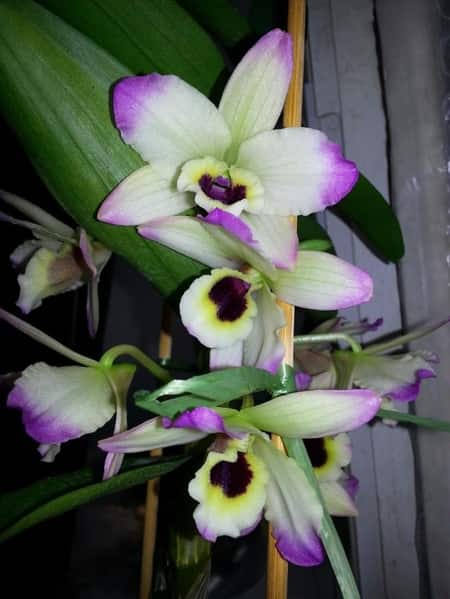

Dendrobium nobile
Oriental Fantasy ‘Aurora‘
4) Dendrobium Latouria
There are around 60 orchid species of Dendrobium Latouria, most of which inhabit the land around New Guinea, Philippines, and Samoa. Some of these orchids have hairy labellums (lips, or the bottom petal where the pollinator can land).
The Dendrobium Latouria orchids are short and stumpy-looking, with smaller rhizomes and pseudobulbs (compared to the cane-like Pseudobulbs).
Dendrobium Latouria orchids are not only epiphytes, but some can be. A few of these dendrobiums can be terrestrial, growing in subalpine grasslands. These orchids are extremely good for intermediate beginners since they can tolerate mild mistakes and are more lenient as we learn and adapt our care for them.
The only thing they don’t forgive is not enough light. They are high light orchids. Living near the equator yet in a higher altitude, they hardly have a winter adjustment at all. Keep the orchid in light and with plenty of water, and a little drier in winter, during its rest.
If you want the full list of the 53 species of Dendrobium Latouria, this page from the Orchids of New Guinea has a list of them all.
has a list of them all.
Some Examples of Species:
- Dendrobium aberrans
- Dendrobium alexanderae
- Dendrobium atroviolaceum
- Dendrobium bifalce
- Dendrobium convolutum
- Dendrobium engae
- Dendrobium eximium
- Dendrobium finisterrae
- Dendrobium forbesii
- Dendrobium johnsoniae
- Dendrobium macrophyllum
- Dendrobium polysema
- Dendrobium rhodostictum
- Dendrobium spectabile
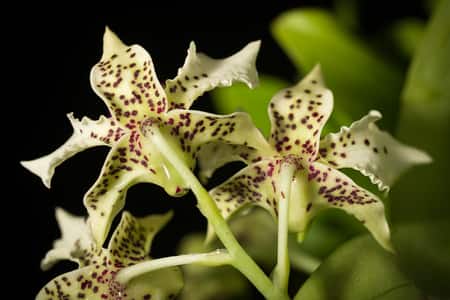
5) Dendrobium Formosae
These orchids grow quite large so make space for growing them. Their blossoms, which can get up to four inches (10.6 cm) are spectacular when in bloom, hence the name Formosa.
The Portuguese sailors and mariners named the island of Taiwan “Formosa” in 1522 since Formosa means beautifully formed, majestically made. In Brazil, this term is used to describe a beautifully-graceful woman.
Another name for this orchid group is the Nigrohirsutae type.
There are originally from the cooler regions in southeast Asia. Countries such as Vietnam, Laos, India, China, and Burma. This means that Dendrobium Formosae enjoy the monsoon weather, with heavy rains and high sun, followed by a cooler season where they dry out. To recreate this same effect, you can suspend watering in early autumn.
In another classification, this would be the group IV.
Some Examples of Species:
- Dendrobium bellatulum
- Dendrobium cruentum
- Dendrobium dearie
- Dendrobium draconis
- Dendrobium formosum
- Dendrobium infundibulum
- Dendrobium sanderae
- Dendrobium scabrilingue
- Dendrobium schuetzei
- Dendrobium sinense
- Dendrobium tobaense
- Dendrobium trigonopus
Image Credit: “石斛蘭 Dendrobium Hsinying Frostymaree [香港公園 Hong Kong Park]” by 阿橋花譜 KHQ Flower Guide is licensed under CC BY-SA 2.0
Dendrobium Hsinying Frostymaree
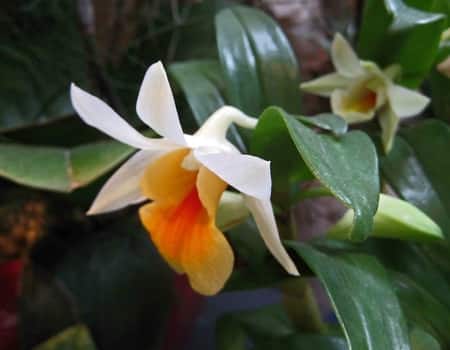
There is always more than one way to do things, which made this article especially hard to write. While researching, I came acroos 3 different ways to classify Dendrobiums. I wish things fell into nice, neatly-compacted categories, but as it turns out, life just isn’t like that.
There other categories of Dendrobium orchids not mentioned above, which depending on who you read, are placed in different spots. Some overlap… It all depends on who you read and who is writing the article.
Several orchids may fit into separate categories such as Callista (or Densiflora), Dendrocoryone (which are found in Australia), Calcarifera, Calyptrochilus, Dockrillia, and the Pedilonum orchids.
You can see this classification being used and tons of pictures of these orchids on their Dendrobium page at St. Augustine Orchid Society. That is just one example. Please click on the other menu items on their page to see all the different types of dendrobiums.
at St. Augustine Orchid Society. That is just one example. Please click on the other menu items on their page to see all the different types of dendrobiums.
Since I didn’t use this type of classification to write this article, please research the name of your orchid to find out more about your orchid’s specific growing conditions. Look for items such as temperature, humidity, lighting, altitude, and fertilization. Try to mimic the same growing conditions of your Dendrobium orchid and you’re half the way there.
Don’t Stop Learning!
If you want to be included in more information and get a 14-page fertilization guide, please sign up for my newsletter. I don’t spam, but send emails out bi-monthly with some curious topics of interest. If you want more information, click here to go to a specific page on this website where I explain it more in detail.

Also, if you are looking for an orchid journal to keep your notes specifically about orchid care, check out my 2 solutions for that on this page. If note-keeping isn’t your thing, then there is a free excel spreadsheet that you can download. Click here for more information on how to do that.
If you subscribe to my newsletter, I will send you a 14-page guide on the main tips of orchid fertilizer. It is downloadable and you can print it out on your computer. I designed the guide to double up as a coloring book, just to make it fun.
Happy Cultivating!


I had hoped to learn about HOW to identify these different types but sadly I did not learn anything much at all. The article strayed from its title by delving into the a;; manner of other Dendrobium related things but omitted the points that for me were key.
How do I recognise a callista orchid plant when I see it, particularly if it isn’t in bloom?
Are there not two different types of Dendrobium dendrobiums?
If it’s not possible to identify the classification without more information, how do I find out? Usually, even when I look up the care of a particular orchid, its type, be it Latouria, Phalaenanthe, spatulata or whatever is rarely given.
Hi Paul,
Thank you for your comment. This is the kind of feedback that I appreciate because, in all honesty, you are absolutely right. I either need to reword the title to more of a classification than an identification theme. I hadn’t even noticed that I had strayed because in my mind I was thinking about another topic entirely. I am sorry that you didn’t find what you were looking for, and it was never my intention of writing something that was off-topic. I’ll make a point to write that article HOW to identify dendrobiums in the future. Again, thanks for pointing that out.
-Amanda
Same here. I am trying to identify an orchid growing in a tree here in the Philippines, very prolific with many drooping flowers. The distictive trait for why I believe it is Dendrobium is three petals growing outwards in a triangle pattern. Anyway I did not see any indication of this flower here. Thanks anyway.
Is there a way i can download & print this? That would be helpful
Hi Kerri,
Right now, there isn’t. I’m putting together printables as we speak, so in the future, there will be.
-Amanda
Good day
Thank you for the very informative article.
May I please put a question to you?
I prefer a Dendrobium that is small in stature and not having long rambling canes since I have limited space.
Do you perhaps have a suggestion?
Kind regards
Hi Michael,
Thank you for reading my article. I appreciate it. I have a Dendrobium parishii, and it’s pretty small. Well, not terrarium small, or mini-mini small, but it’s about the size of my open hand. The flowers are tiny and bright pink. I think that one is perfect for a smaller dendrobium.
Good Article- I am trying to ID a Dendrobium that has Fern like leaves. Very long, thin, round branching
leaves. I have heard there are only 2 in this section. One is fragrant, mine is.
I need cultural info on this section. Can you help?
Dear Mam,
Such a great Article I found very useful as a beginner like me on field of orchid growing. I am in this field since 4-5 years. information in it,it will definitely help in growing dendrobium.
Thanks from India
I have a dendrobium triple fantasy has never bloomed is 14 inches tall under lights now has purple stripes on canes what class dendrobium is this?
Wait…. Dendrobium…bright light…. Dendrobium…. Northern exposure…. Meh?
Internet advice is SO varied! Tell me… what exposure do You grow Your Parishii, Please ?!
Wow! Great information. I purchased an unusual Dendrobium from Trader Joe’s but unfortunately it had no ID tag. The way it blossomed was unusual with flower stems coming out below a set of leaves and hanging dependent. The good news is that it is getting ready to bloom again! I realized that there are so many different types of Dendrobiums I may never identify and enter it into my AM spreadsheet. Oh well, thanks for all you do. Being a retired academic, I love your organization.